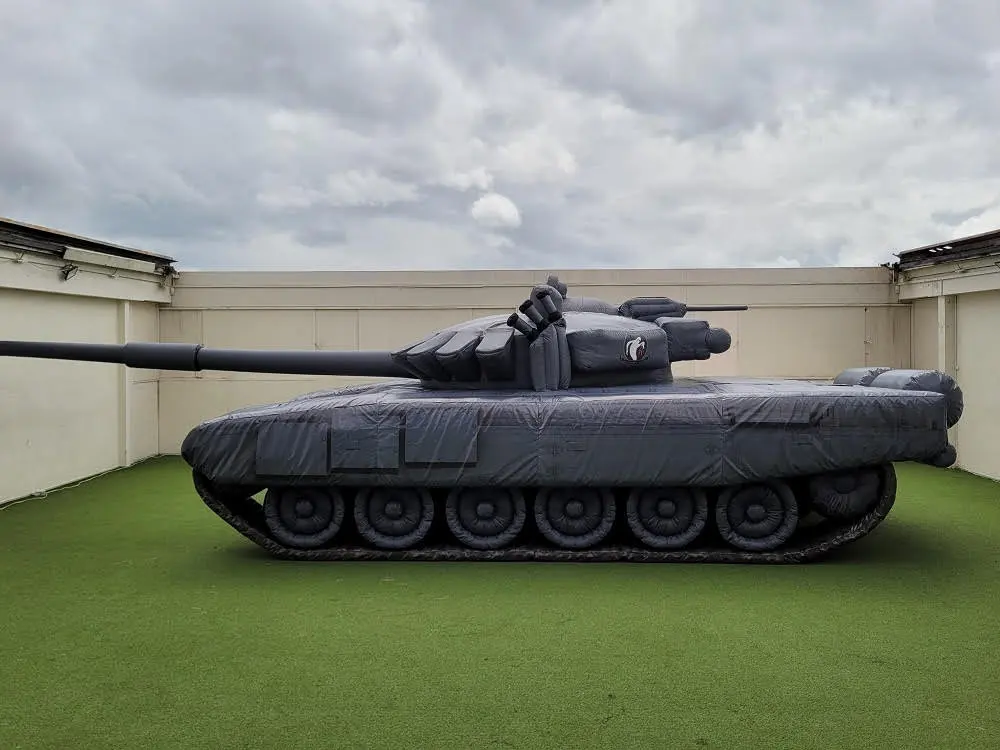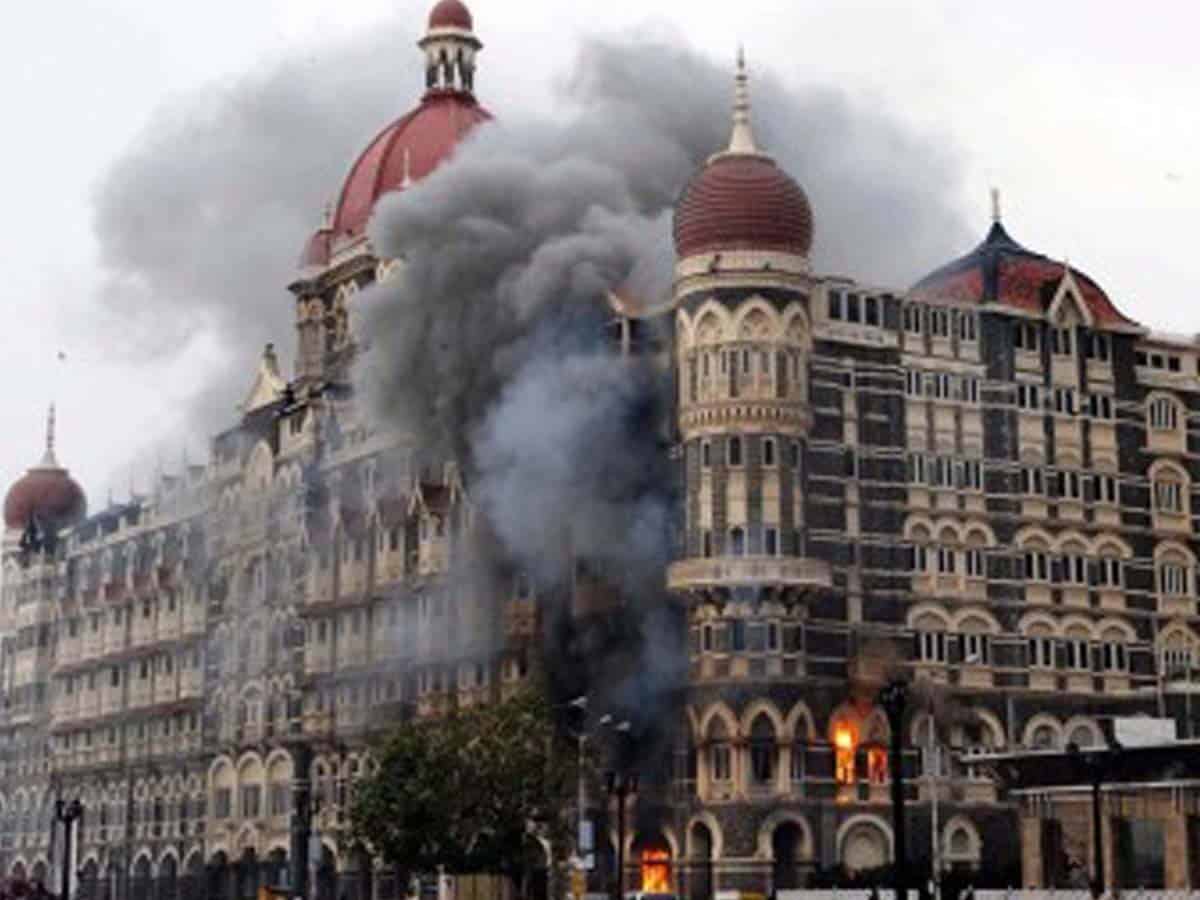SOURCE: IDRW.ORG


In a strategic move to enhance force protection and bolster its armoured capabilities, the Indian Army has issued a Request for Information (RFI) for the procurement of mock-ups for its T-90 S/SK main battle tanks. Released under the Government of India’s ‘Make in India’ initiative, the RFI invites Defence Public Sector Undertakings (DPSUs) and private Indian vendors to develop these decoy systems, marking a proactive response to evolving battlefield threats, particularly from drones.
The RFI, aimed at identifying capable vendors, outlines the critical role of these mock-ups in preserving the operational integrity of the T-90 S/SK fleet. Advancements in surveillance, detection, and targeting technologies have rendered modern battlefields increasingly transparent, with drones emerging as a significant threat to armoured units. The mock-ups are designed to deceive enemy sensors and drones by replicating the acoustic, thermal, and dimensional signatures of in-service T-90 tanks, thereby diverting attacks away from actual assets.
Continue readingSOURCE: IDRW.ORG


The Indian Army’s recent decision to order 2,978 Force Gurkha vehicles from Force Motors, as announced on April 3, 2025, has sparked intense debate among defense enthusiasts. This landmark order, valued in the crores, underscores the Army’s trust in the Gurkha over competitors like the Mahindra Thar and Maruti Suzuki Jimny for its military operations. But why did the Army opt for the Gurkha, especially when the Thar boasts superior power and the Jimny offers lightweight reliability? The answer lies in a mix of historical ties, battlefield suitability, and strategic alignment with India’s defense needs.
Force Motors’ relationship with the Indian Army dates back to 1958, when the company—then known as Bajaj Tempo—began operations in India. Its first offering, the Tempo Hanseat, a three-wheeled utility vehicle, was quickly adopted by the Army for light transport duties. Often dubbed the “pig” for its squat, rugged design, the Hanseat ferried troops and supplies in non-combat zones, proving its worth in logistics. By 1969, Force Motors introduced the Tempo Matador, a commercial van with a spacious rear bed, which the Army used extensively to transport troops, goods, and even large ammunition. While exact numbers are unavailable, the Matador’s ubiquity in military depots during the 1970s suggests procurement in the thousands—a testament to Force Motors’ early reliability.
Continue readingSOURCE: AFI
.png)

Adani Defence and Aerospace (@AdaniDefence) has made a powerful entry into the global ammunition market, leveraging its state-of-the-art manufacturing capabilities to meet surging international demand. With a strategic focus on exports, the company is positioning India as a key player in the defence supply chain while reserving significant capacity for domestic needs.
The Kanpur-based facility, one of South Asia’s largest integrated ammunition complexes, is already scaling up production. For small arms ammunition, Adani Defence has a current capacity of 150 million rounds annually, with plans to double this to 300 million rounds by the end of 2025. This expansion has been met with strong global interest, as evidenced by export orders already booked for the next two years. The facility produces a range of small-calibre rounds, including 5.56x45mm, 7.62x51mm, and 9x19mm, catering to rifles, carbines, and pistols used by armed forces worldwide.
Continue readingSOURCE: AFI


India’s Northeast, long known for its scenic beauty and rugged terrain, is rapidly transforming into an unexpected haven for high-speed motorsports. The region’s newly developed expressways, coupled with minimal traffic, have caught the attention of Indian supercar owners seeking the ultimate thrill of speed. These modern roads, stretching through the lush landscapes of states like Arunachal Pradesh, Assam, and Meghalaya, are becoming a playground for automotive enthusiasts eager to test the limits of their high-performance machines.
The catalyst for this phenomenon lies in India’s strategic push to bolster infrastructure along its borders. The government’s policy of constructing high-quality roads to facilitate armed forces logistics and promote border tourism has inadvertently created a paradise for supercar drivers. These expressways, designed for efficiency and connectivity, offer long, smooth stretches with sparse traffic—perfect conditions for pushing Lamborghinis, Ferraris, and Porsches to their limits.
Continue readingSOURCE: AFI


On April 12, 2025, Ukraine suffered a significant blow with the loss of a U.S.-made F-16 fighter jet during a combat mission, resulting in the death of its 26-year-old pilot, Captain Pavlo Ivanov. The Ukrainian Air Force confirmed the incident, stating, “On April 12, 2025, while performing a combat mission on an F-16 aircraft, 26-year-old Pavlo Ivanov died (…) he died in combat.” According to a BBC report, the jet was likely shot down by Russian forces, with either an R-37 air-to-air missile or a surface-to-air missile from an S-400 air defense system as the probable culprits. The lack of detailed disclosure from Kyiv has fueled speculation and highlighted the intense technological and tactical struggle unfolding in Ukraine’s skies.
This marks the second confirmed loss of an F-16 for Ukraine since the jets were delivered by Western allies in 2024. The first incident occurred on August 26, 2024, when pilot Oleksii Mes, call sign “Moonfish,” perished while countering a massive Russian missile attack. Although Ukraine launched an investigation, no conclusive findings were released. A Wall Street Journal report suggested friendly fire from a Patriot air defense system or mechanical failure as possible causes, though these remain unconfirmed. The ambiguity surrounding both incidents underscores the challenges of operating advanced Western aircraft in a contested airspace dominated by sophisticated Russian defenses.
Continue readingSOURCE: AFI


In a groundbreaking leap for India’s space ambitions, Bengaluru-based Ethereal Exploration Guild Private Limited has unveiled the country’s most advanced semi-cryogenic RP-1 test setup, designed for its ambitious Pegasus engine development program. Rated to withstand pressures up to 200 bar, this state-of-the-art facility marks a significant milestone in indigenous propulsion technology, positioning India as a serious contender in the global space race.
The RP-1 test skid, a critical component for validating semi-cryogenic rocket engines, is engineered to handle high flow rates with unparalleled precision. With real-time responsiveness and a closed-loop response time of just 360 milliseconds, the setup allows Ethereal’s engineers to exert deep control over tank pressure, line pressure, and flow rates. This level of fidelity is essential for tuning and validating the complex propulsion systems that will power the Pegasus engine, a cornerstone of the company’s vision for affordable and reliable space access.
Continue readingSOURCE: AFI


The Parliamentary Standing Committee on Defence, chaired by Shri Radha Mohan Singh, visited the Solid State Physics Laboratory (SSPL) of the Defence Research and Development Organisation (DRDO) in Delhi today, gaining firsthand insight into India’s strides toward self-reliance in cutting-edge defence technologies. The committee was briefed on SSPL’s pioneering work in advanced semiconductors, optoelectronics, and next-generation materials, underscoring DRDO’s pivotal role in bolstering India’s Atmanirbhar Bharat initiative.
During the visit, the committee witnessed a showcase of SSPL’s innovations, including advancements in Silicon Carbide (SiC) technology, infrared (IR) devices, Gallium Nitride (GaN) and Gallium Arsenide (GaAs) Monolithic Microwave Integrated Circuits (MMICs), sensors, Terahertz (THz) technologies, and quantum technology. These breakthroughs are critical for developing indigenous defence systems, ranging from radar and missile guidance to secure communications and electronic warfare.
Continue readingSOURCE: ANI


The Indian Army recently brought down a Pakistan Army drone using the indigenously designed and developed ‘Integrated Drone Detection and Interdiction System’ while it was trying to carry out surveillance along the Line of Control (LoC) in the Jammu region. According to defence sources, the drone — of Chinese origin — was brought down by Army Air Defence units deployed in the 16 Corps area, located south of the Pir Panjal ranges in the Jammu region.
The incident occurred when the hostile drone was detected operating close to Indian territory along the LoC, they said. Sources said that the drone was brought down using the indigenously designed and developed ‘Integrated Drone Detection and Interdiction System,’ which is capable of jamming, spoofing, and bringing down enemy drones across a variety of ranges and scenarios.
Continue readingSOURCE: PTI
)

Navy Chief Admiral Dinesh K Tripathi on Saturday began a five-day trip to Tanzania primarily to witness a mega wargame involving the naval forces of India and several African nations. The Indian Navy and the Tanzania Peoples Defence Force are the co-hosts of the naval exercise titled ‘AIKEYME’ or Africa-India Key Maritime Engagement off Dar-es-Salaam that will begin on Sunday.
The aim of the wargame is to boost India’s maritime security cooperation with the African continent in line with Prime Minister Narendra Modi’s new vision for engagement with the Global South.
Continue readingSOURCE: PTI
)

India needs a nuclear energy renaissance and the US is interested in helping the country develop a nuclear infrastructure as both nations have a vital shared interest in this area, Holtec CEO Dr Kris Singh has said, voicing optimism that things will move forward under Prime Minister Narendra Modi.
India and the US have shared strategic interest in clean energy. Nuclear power should be a unifier and India should naturally take the lead there. For that, India needs to have an exportable technology, Singh told PTI in an exclusive interview at the sprawling Krishna P Singh Technology Campus in Camden, New Jersey.
Continue readingSOURCE: IANS


The Central government has appointed Advocate Narender Mann as the Special Public Prosecutor for the 26/11 Mumbai terror attack case hearing. The Ministry of Home Affairs issued a gazette notification on Wednesday in this regard.
The notification, which is signed by Joint Secretary Adhijit Sinha, says that Mann has been appointed for a period of three years or till the completion of the trial of the said case, whichever is earlier, “In exercise of the powers conferred by sub-section (1) of section 15 of the National Investigation Agency Act, 2008 (34 of 2008), read with sub-section (8) of section 18 of the Bharatiya Nagarik Suraksha Sanhita, 2023 (BNSS), the Central Government hereby appoints Narender Mann, Advocate, as Special Public Prosecutor for conducting trial and other matters related to NIA case RC-04/2009/NIA/DLI on behalf of the NIA before the NIA Special Courts at Delhi and Appellate Courts, for a period of three years from the date of publication of this notification or till the completion of trial of the said case, whichever is earlier,” the notification states.
Continue readingSOURCE: PTI
)

Russia has planned programmes in Delhi and several Indian cities, alongside mega celebrations in Moscow, to mark Victory Day on May 9, the country’s envoy Denis Alipov said on Saturday. Russia has invited Prime Minister Narendra Modi to attend the celebrations in Moscow that will mark the 80th anniversary of the Soviet Union’s triumph over Nazi Germany in World War II.
“This year is very special. This year, we celebrate the 80th anniversary of the Great Victory. We call it the Great Victory in Russia… We will have big celebrations in Moscow on May 9 and we will be happy to welcome a high-level Indian delegation, whoever goes, we will welcome the defence minister And, if the prime minister decides to go, we will certainly welcome the prime minister,” Alipov, the Russian ambassador to India, told reporters on the sidelines of an event.
Continue readingSOURCE: ANI
)

April 13 marks Siachen Day, commemorating the Indian Army’s Operation Meghdoot in 1984. On this day, Indian troops landed at Bilafond La Pass and captured key positions on the Siachen Glacier, securing a strategic advantage in the disputed region of Kashmir, the world’s highest battlefield.
The poem “Quartered in snow, Silent to remain, When the clarion calls, They shall rise and march again” beautifully captures the spirit of the Indian Army’s presence in Siachen. It highlights the soldiers’ ability to remain vigilant and prepared, even in the harshest of conditions, and to respond swiftly when called upon to defend the nation.
Continue readingSOURCE: PTI

A Jharkhand Jaguar constable was killed, while a CRPF jawan was injured in an IED blast in Jharkhand’s West Singhbhum district on Saturday, a police officer said.
The incident took place in the Radhapora area under Jaraikela police station limits, he said. “Two jawans — one from CoBRA 203 battalion and another from Jharkhand Jaguar — were injured in the incident. Both were airlifted to Ranchi for better treatment,” Kolhan DIG Manoj Ratan Chothe told PTI.
Continue readingSOURCE: PTI

The Border Security Force (BSF) on Sunday said that a 50-year-old man, who was recently found wandering near the International Border (IB) in Akhnoor sector here, was reunited with his family.
Venkata Rao, hailing from Andhra Pradesh, was missing from home for three months and his safe return brought immense relief and joy to his family, the BSF said, reaffirming its commitment to both border security and social responsibility.
Continue reading